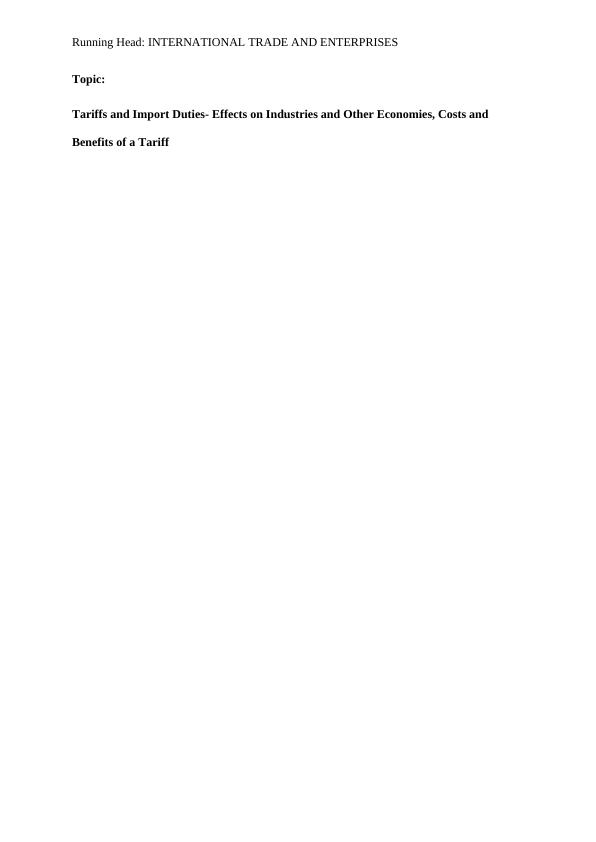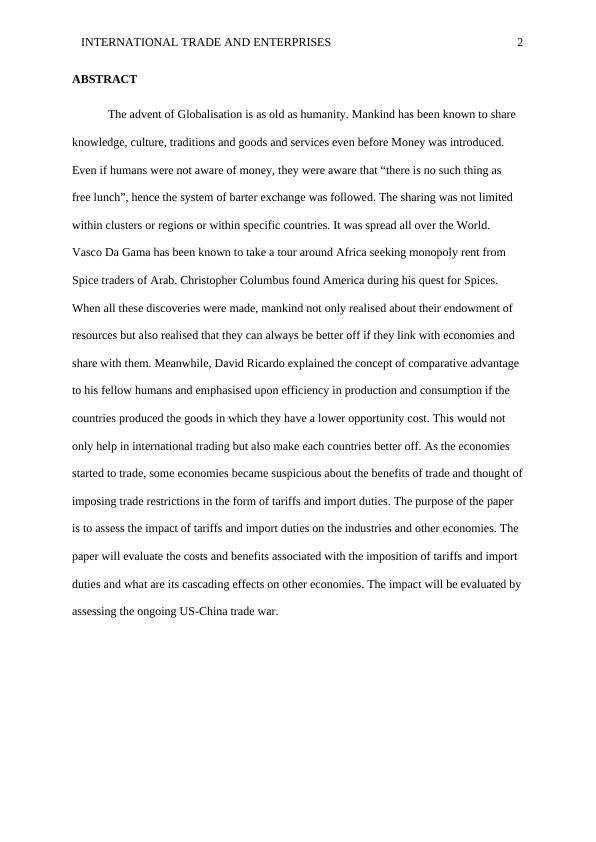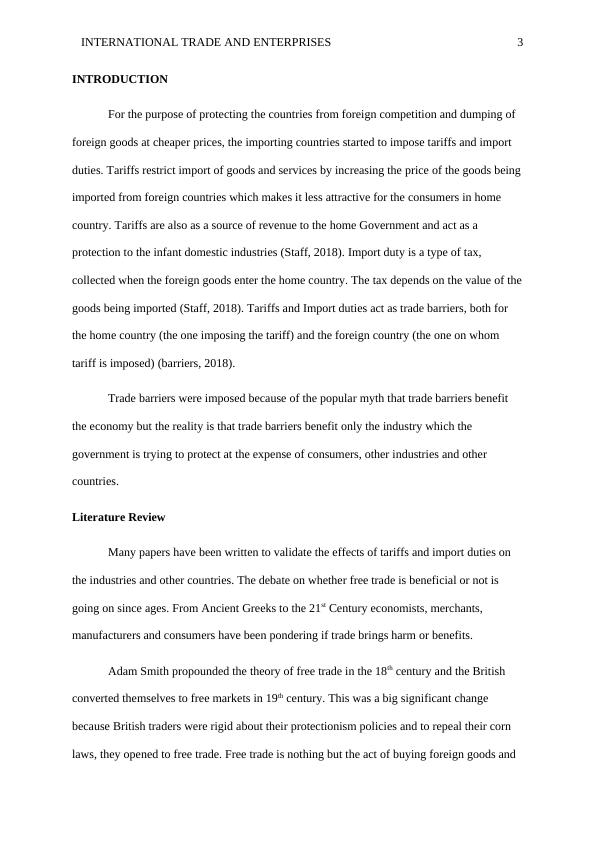Tariffs and Import Duties- Effects on Industries and Other Economies, Costs and Benefits of a Tariff
Added on 2023-06-05
13 Pages3673 Words475 Views
Running Head: INTERNATIONAL TRADE AND ENTERPRISES
Topic:
Tariffs and Import Duties- Effects on Industries and Other Economies, Costs and
Benefits of a Tariff
Topic:
Tariffs and Import Duties- Effects on Industries and Other Economies, Costs and
Benefits of a Tariff

INTERNATIONAL TRADE AND ENTERPRISES 2
ABSTRACT
The advent of Globalisation is as old as humanity. Mankind has been known to share
knowledge, culture, traditions and goods and services even before Money was introduced.
Even if humans were not aware of money, they were aware that “there is no such thing as
free lunch”, hence the system of barter exchange was followed. The sharing was not limited
within clusters or regions or within specific countries. It was spread all over the World.
Vasco Da Gama has been known to take a tour around Africa seeking monopoly rent from
Spice traders of Arab. Christopher Columbus found America during his quest for Spices.
When all these discoveries were made, mankind not only realised about their endowment of
resources but also realised that they can always be better off if they link with economies and
share with them. Meanwhile, David Ricardo explained the concept of comparative advantage
to his fellow humans and emphasised upon efficiency in production and consumption if the
countries produced the goods in which they have a lower opportunity cost. This would not
only help in international trading but also make each countries better off. As the economies
started to trade, some economies became suspicious about the benefits of trade and thought of
imposing trade restrictions in the form of tariffs and import duties. The purpose of the paper
is to assess the impact of tariffs and import duties on the industries and other economies. The
paper will evaluate the costs and benefits associated with the imposition of tariffs and import
duties and what are its cascading effects on other economies. The impact will be evaluated by
assessing the ongoing US-China trade war.
ABSTRACT
The advent of Globalisation is as old as humanity. Mankind has been known to share
knowledge, culture, traditions and goods and services even before Money was introduced.
Even if humans were not aware of money, they were aware that “there is no such thing as
free lunch”, hence the system of barter exchange was followed. The sharing was not limited
within clusters or regions or within specific countries. It was spread all over the World.
Vasco Da Gama has been known to take a tour around Africa seeking monopoly rent from
Spice traders of Arab. Christopher Columbus found America during his quest for Spices.
When all these discoveries were made, mankind not only realised about their endowment of
resources but also realised that they can always be better off if they link with economies and
share with them. Meanwhile, David Ricardo explained the concept of comparative advantage
to his fellow humans and emphasised upon efficiency in production and consumption if the
countries produced the goods in which they have a lower opportunity cost. This would not
only help in international trading but also make each countries better off. As the economies
started to trade, some economies became suspicious about the benefits of trade and thought of
imposing trade restrictions in the form of tariffs and import duties. The purpose of the paper
is to assess the impact of tariffs and import duties on the industries and other economies. The
paper will evaluate the costs and benefits associated with the imposition of tariffs and import
duties and what are its cascading effects on other economies. The impact will be evaluated by
assessing the ongoing US-China trade war.

INTERNATIONAL TRADE AND ENTERPRISES 3
INTRODUCTION
For the purpose of protecting the countries from foreign competition and dumping of
foreign goods at cheaper prices, the importing countries started to impose tariffs and import
duties. Tariffs restrict import of goods and services by increasing the price of the goods being
imported from foreign countries which makes it less attractive for the consumers in home
country. Tariffs are also as a source of revenue to the home Government and act as a
protection to the infant domestic industries (Staff, 2018). Import duty is a type of tax,
collected when the foreign goods enter the home country. The tax depends on the value of the
goods being imported (Staff, 2018). Tariffs and Import duties act as trade barriers, both for
the home country (the one imposing the tariff) and the foreign country (the one on whom
tariff is imposed) (barriers, 2018).
Trade barriers were imposed because of the popular myth that trade barriers benefit
the economy but the reality is that trade barriers benefit only the industry which the
government is trying to protect at the expense of consumers, other industries and other
countries.
Literature Review
Many papers have been written to validate the effects of tariffs and import duties on
the industries and other countries. The debate on whether free trade is beneficial or not is
going on since ages. From Ancient Greeks to the 21st Century economists, merchants,
manufacturers and consumers have been pondering if trade brings harm or benefits.
Adam Smith propounded the theory of free trade in the 18th century and the British
converted themselves to free markets in 19th century. This was a big significant change
because British traders were rigid about their protectionism policies and to repeal their corn
laws, they opened to free trade. Free trade is nothing but the act of buying foreign goods and
INTRODUCTION
For the purpose of protecting the countries from foreign competition and dumping of
foreign goods at cheaper prices, the importing countries started to impose tariffs and import
duties. Tariffs restrict import of goods and services by increasing the price of the goods being
imported from foreign countries which makes it less attractive for the consumers in home
country. Tariffs are also as a source of revenue to the home Government and act as a
protection to the infant domestic industries (Staff, 2018). Import duty is a type of tax,
collected when the foreign goods enter the home country. The tax depends on the value of the
goods being imported (Staff, 2018). Tariffs and Import duties act as trade barriers, both for
the home country (the one imposing the tariff) and the foreign country (the one on whom
tariff is imposed) (barriers, 2018).
Trade barriers were imposed because of the popular myth that trade barriers benefit
the economy but the reality is that trade barriers benefit only the industry which the
government is trying to protect at the expense of consumers, other industries and other
countries.
Literature Review
Many papers have been written to validate the effects of tariffs and import duties on
the industries and other countries. The debate on whether free trade is beneficial or not is
going on since ages. From Ancient Greeks to the 21st Century economists, merchants,
manufacturers and consumers have been pondering if trade brings harm or benefits.
Adam Smith propounded the theory of free trade in the 18th century and the British
converted themselves to free markets in 19th century. This was a big significant change
because British traders were rigid about their protectionism policies and to repeal their corn
laws, they opened to free trade. Free trade is nothing but the act of buying foreign goods and

INTERNATIONAL TRADE AND ENTERPRISES 4
services at the market price, i.e. without any restrictions or tax. In their paper Dakhlia & Nye
(2004) computes a general equilibrium model to simulate the drop of British tariffs to zero.
They assessed that the tariffs being imposed by them was way above the optimum tariff level
and these tariffs were resulting in welfare loss. The removal of British tariffs resulted in net
welfare and asserted that their policy was inconsistent with the theory of pure trade.
Before the onset of the Great Depression, the tariffs imposed by the Latin Americans
were among the highest in the world. During the 1920s, it was Latin America who exploited
globalisation the most but by 1930s, it was Latin America itself who became the most Anti-
Global. Tariffs are imposed not only to protect the domestic industries but also to meet the
revenue needs of the Government and to balance the trade deficit. Coatsworth and
Williamson (2004) researched about the wide changes on tariff impositions in Latin America
and according to them – during the decade before the Great Depression (1914), tariffs were
rising in Latin America. The question arose that if Latin America favoured globalisation, then
why were tariffs so high before World War? The paper suggests that the Great Depression
acted as a turning point and the imposition of high tariffs helped the domestic producers who
were competing in the foreign market and made their share in the export oriented economy.
Latin America had more revenue needs than the protection of domestic countries.
Irwin (1998) analyses the fiscal aspects of the great tariff debate of 1888. After the
Civil war was over, the U.S. government had accumulated high public debts. To repay the
debt, high tariffs were imposed – it would raise the required revenue and also protect
industries. By 1880s, FED had a huge budget surplus and both the Democrats and the
Republicans were against the tariff policy. According to the Republicans, a lower import duty
would lead to increas e in imports and reduced the surplus but nothing could be clearly said
about the tariff recipients. The elasticity of demand for imports and the elasticity of supply of
exports plays a huge role in determination of tariffs and import duties.
services at the market price, i.e. without any restrictions or tax. In their paper Dakhlia & Nye
(2004) computes a general equilibrium model to simulate the drop of British tariffs to zero.
They assessed that the tariffs being imposed by them was way above the optimum tariff level
and these tariffs were resulting in welfare loss. The removal of British tariffs resulted in net
welfare and asserted that their policy was inconsistent with the theory of pure trade.
Before the onset of the Great Depression, the tariffs imposed by the Latin Americans
were among the highest in the world. During the 1920s, it was Latin America who exploited
globalisation the most but by 1930s, it was Latin America itself who became the most Anti-
Global. Tariffs are imposed not only to protect the domestic industries but also to meet the
revenue needs of the Government and to balance the trade deficit. Coatsworth and
Williamson (2004) researched about the wide changes on tariff impositions in Latin America
and according to them – during the decade before the Great Depression (1914), tariffs were
rising in Latin America. The question arose that if Latin America favoured globalisation, then
why were tariffs so high before World War? The paper suggests that the Great Depression
acted as a turning point and the imposition of high tariffs helped the domestic producers who
were competing in the foreign market and made their share in the export oriented economy.
Latin America had more revenue needs than the protection of domestic countries.
Irwin (1998) analyses the fiscal aspects of the great tariff debate of 1888. After the
Civil war was over, the U.S. government had accumulated high public debts. To repay the
debt, high tariffs were imposed – it would raise the required revenue and also protect
industries. By 1880s, FED had a huge budget surplus and both the Democrats and the
Republicans were against the tariff policy. According to the Republicans, a lower import duty
would lead to increas e in imports and reduced the surplus but nothing could be clearly said
about the tariff recipients. The elasticity of demand for imports and the elasticity of supply of
exports plays a huge role in determination of tariffs and import duties.

End of preview
Want to access all the pages? Upload your documents or become a member.
Related Documents
Effects of Tariffs on Industries and the Economylg...
|9
|3885
|80
Tariff and Import Duties : Reportlg...
|13
|3586
|41
Economic Arguments for and against US Tariffs on Chinese Goodslg...
|8
|2116
|411
Tariffs and Import Duties Impact on Australian Economylg...
|10
|649
|406
Tariff, Quotas, Non-Tariff Barrier in International Marketinglg...
|6
|1092
|61
Technical Barriers to International Trade and Their Impactslg...
|13
|3318
|303